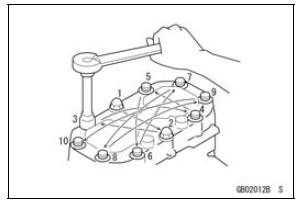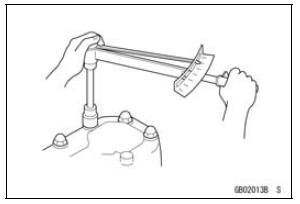

Generally, when installing a part with several bolts, nuts, or screws, start them all in their holes and tighten them to a snug fit. Then tighten them according to the specified sequence to prevent case warpage or deformation which can lead to malfunction. Conversely when loosening the bolts, nuts, or screws, first loosen all of them by about a quarter turn and then remove them. If the specified tightening sequence is not indicated, tighten the fasteners alternating diagonally.

Tightening Torque
Incorrect torque applied to a bolt, nut, or screw may lead to serious damage. Tighten fasteners to the specified torque using a good quality torque wrench.

 Replacement Parts
Replacement Parts Force
ForceSteering Damper Oil Leak Inspection
Visually inspect the steering damper [A] for oil leakage.
If the oil leakage is found on it, replace the steering
damper with a new one (see Steering Damper Removal/
Installation in the Steering chapter).
ZX1000JD/KD [B]
...
Check 2-2: Fuel Level Warning Inspection
Remove:
Fuel Tank (see Fuel Tank Removal in the Fuel System
(DFI) chapter)
Connect the resistor(s) [A] (about 50 to 100 Ω) between
the fuel pump connector terminal [B] of the main harness
side and the battery negative (–) terminal [C] as shown.
Turn the ignition switch ...
Intake Air Pressure Sensor #2 Installation
NOTE
The intake air pressure sensor #2 is the same part as
the intake air pressure sensor #1.
Installation is basically the reverse of removal.
Position the intake air pressure sensor #2 [A] between the
projections [B] on the rubber damper.
Install the rubber damper [A] on the brac ...